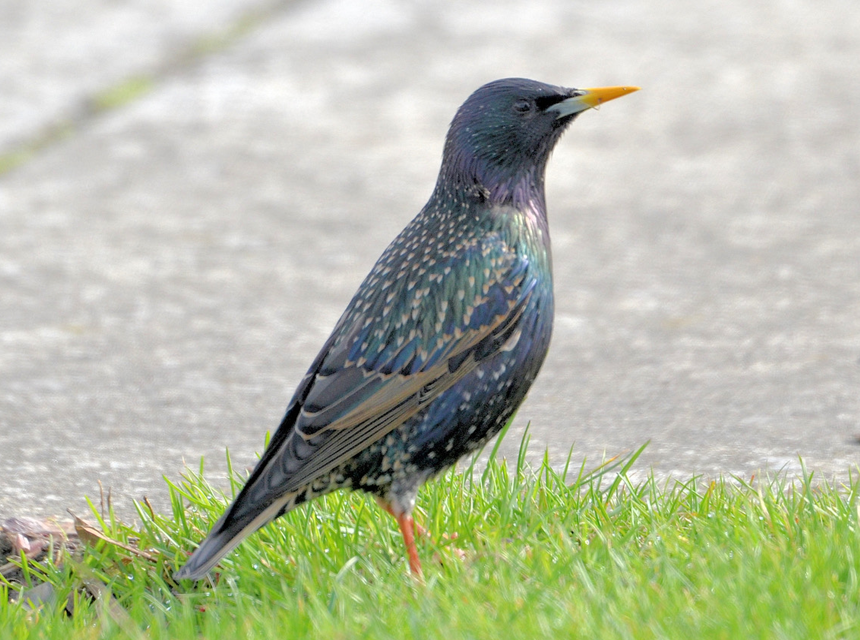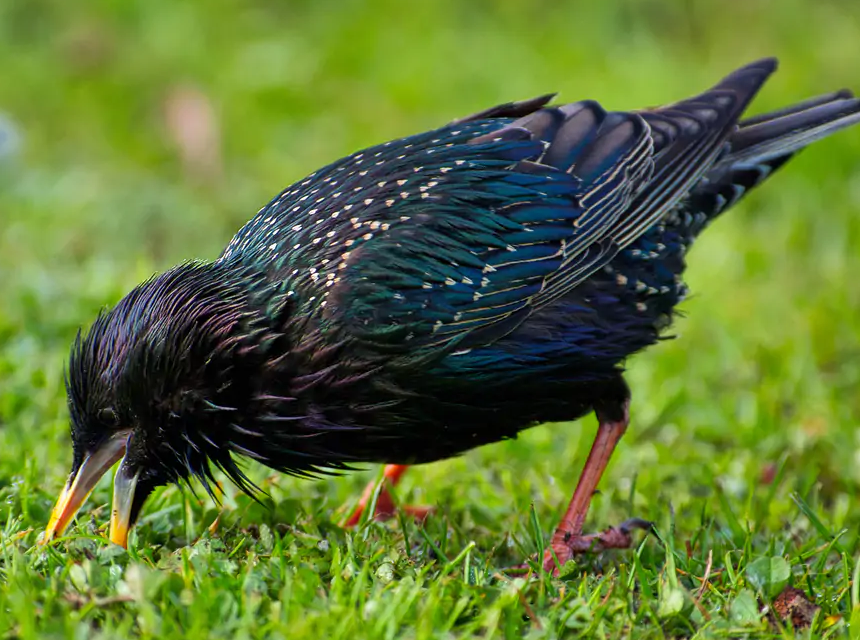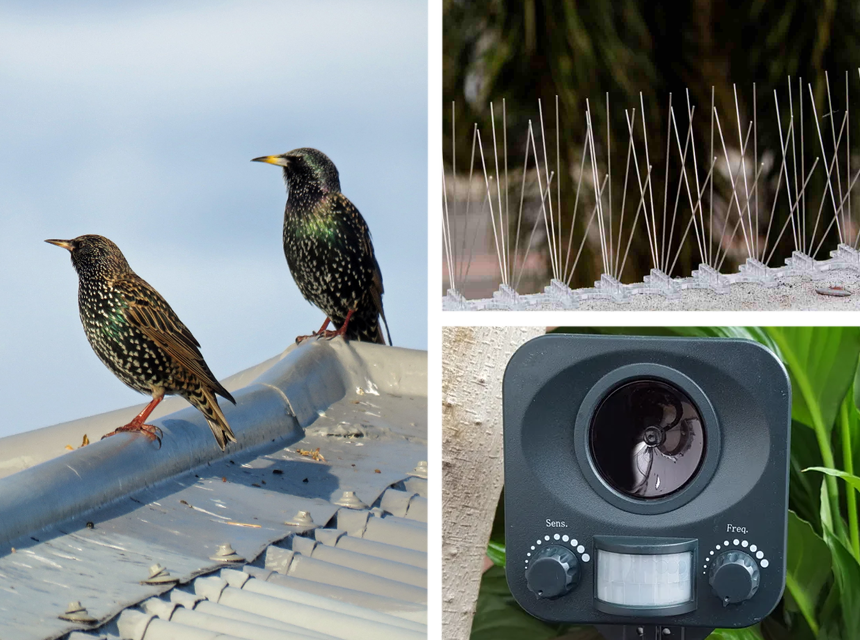

Starlings, like so many other birds, can make a big mess of your yard and the eaves of your home. You might end up with droppings all over your property, and the droppings of these birds are acidic enough to damage paint, decking, and masonry. Starlings can also clog gutters and create various other kinds of damage to your home. So, the question of how to get rid of starlings arises.
Many people do not want birds to nest on their property to avoid risks of disease and the incursion of predatory animals like cats looking for a snack. European Starlings are some of the most difficult birds to eradicate, and they can cause more damage than many other kinds of birds as well. If you have these birds roosting and nesting on your house or around your property, you probably are in a hurry to get rid of them.
If you want to know some more about how to get rid of starlings on a farm or how to get rid of starlings in your yard, you need to keep reading.
European starlings are medium-sized birds with black feathers that have a metallic sheen. Their legs are pink in color, and they have short, triangle-shaped wings. They are usually about 6” long and have pointed yellow beaks. They are darker in the fall than in the earlier parts of the year. These birds count as a songbird, but they are so aggressive and messy that many people do not consider them in the same pleasant category as other songbirds.
The European Starling was brought to Northern America by lovers of Shakespeare in the 19th century. They are among the most numerous bird varieties on the North American continent these days, and flocks of starlings can be quite noisy due to their large numbers.

As stated above, these birds were brought to North America by lovers of Shakespeare in the mid-19th century. They are an invasive species and have overtaken many of the other songbird populations in areas where they were first introduced. The first birds that were introduced were set loose in New York in Central Park. These 100 birds have grown into the excessively large population that exists today. Starlings were intended to be localized to the New York area by their original supporters, but they quickly spread out across the entire continent.
Starlings are drawn to yards by available food sources at bird feeders and by easy nesting locations. They can also move into the nests of other birds and will throw eggs left by other birds out so that they can lay their own in the existing nest. Starlings love a good perching location, and they tend to congregate on gutters or in vents around the exterior of your home. When you have fruit trees in the yard, they might also show up to feed on this food source.
Starlings are very noisy. While they might correctly be identified as songbirds, they are not pleasant to listen to and are not the kind of bird that most people want singing in their yard. They also tend to travel in large groups, making the sound exponentially more invasive than in other kinds of birds. Both adults and juveniles can be equally noisy, which makes the entire population of starlings frustrating for homeowners and for business owners.
Starlings, just like many other bird species, can carry a variety of diseases as well as lice. Droppings from starlings can carry salmonella, histoplasmosis, and some other bacterial and viral infections. They might also carry fungal infections that can make you and your family or your pets sick. Starlings are not just noisy and messy; they can also be vectors for disease.
Starling droppings are very acidic, and they can ruin paint, the finishes of metal items, and wood as well. They can also be really slippery, which can lead to slip and fall hazards along walkways or near buildings. Many people find that they need to hire a bunch of different kinds of maintenance people to repair the damages that are done after starlings have been living in an area for a long time. Droppings can also bring with them disease vectors.

Starlings that are looking for food can peck spots bald in your lawn. They might also damage your garden and your flowers. People who have gardens might find that their crops are destroyed within a matter of weeks if starlings are not removed from the property. Starlings might not even be interested in the items that they are pecking at, but they are so destructive that they only care about moving things out of the way to look for food.
Starlings trying to nest and looking for food, as well as starlings that are perched in large groups, can easily clog your gutters. The gutters on your home need to be clear to drain properly, but flocks of starlings that are sitting at the edge of the roof and hunting for food can easily clog your gutters. Gutters are one of the first things that can be damaged and clogged by starlings, but many people do not realize that the gutters are a mess until the winter when they fail.
Starlings are very fast and very fertile breeders, and each mated pair can have 2-3 broods a year. This is why there are so many starlings in North America, and your home and yard can easily become the roost for hundreds of starlings within a season or two. The tremendous population growth potential of these birds is a big part of why they are a terrible nuisance when they move into people’s yards.
Getting rid of starlings can feel like it is impossible, but there are lots of ways to discourage starlings from staying on your property. You might need to try a combination of these tips and tricks to remove starlings from your property for good.
One of the first questions that many people have is how to get rid of starlings at feeders. If you like to feed other kinds of birds, you don’t want to be giving away bird seed to unwanted pests like starlings. Restrictive feeders are the best solution to keep starlings from thinking that they will be well-fed. Mesh designs or feeders with small openings can help to keep these larger birds from feeding at your feeders. You will want to feed smaller birds like finches and be sure that you are not feeding starlings and their broods. Domed feeders are often inaccessible to larger birds like starlings as well, which can make them a great restrictive feeder.
Make sure that you are choosing the feed that you are offering wisely. You should not be feeding suet, kitchen scraps, or cracked corn if you don’t want to have starlings moving into your home and yard in droves. Nyjer seed, safflower seed, nectar, and whole peanuts are much less interesting to these birds.
Weight-sensitive feeders are usually made for rodents and squirrels, but they can work for starlings as well. When a heavier bird, like a starling, lands on this kind of feeder, it will adjust the holes of the feeder to close them off. This is a very clever and simple solution to the prevention of birds like starlings from accessing bird feed in your feeders.
You will also be wise to remove natural sources of food like apple trees, windfall fruits, and fruit-bearing shrubs. If you can cover your fruit-bearing plants so that starlings cannot get to them, this will save your fruit-bearing plants from being eaten by starlings.
To get rid of starlings in a roof, you will probably want to make use of the best ultrasonic bird repellerthat you can buy. This is a really helpful device if you are dealing with starlings in locations that are hard to reach or where it is difficult to apply other deterrents. This is also one of the best ways to get rid of starlings in a barn.
An additional benefit to using an ultrasonic repeller is that this is a great solution if you are wondering how to get rid of chipmunks and rats as well. Rodents are best removed with the best outdoor rat traps, but you can help discourage pests of various kinds from moving into your home and your yard with a repeller. This is also an ideal solution for many people since the tone made by the repeller will not bother humans in the home or the yard.
Many people also employ bird spikes to keep starlings from roosting on surfaces that they want to be bird-free and to keep them from building nests in places where they are not welcome to make their homes. These are simple solutions to discourage other birds from doing the same thing if you have been having issues with crows or other loud birds wanting to move in and make your home their home.

Barns are one of the places that starlings love to nest. You will need to be sure that you are preventing nesting if you want to make sure that starlings move out as soon as possible. They love to nest in vents in homes as well as gutters, but barns with lofts and lots of nooks and crannies are ideal for starling nests. Starlings are not protected in most places, so you are allowed to remove their nests and throw out their eggs as you try to remove them from your property.
Barns can also be rife with food that these birds love. Make sure that you keep sources of grain and corn locked up and clean up any messes of these kinds of items to that starlings cannot get to them. Drawing starlings into a barn to make a nest can be easy because there are often food sources that they want to enjoy everywhere inside a barn.
Removing nests from the rooftop areas in your barn and the loft is essential to get rid of your starling population. You can remove their nests by hand, or you might want to get a pole or a broom to knock them down. If you have empty nests in your barn from last year’s birds, you should remove them before starlings move into them.
If you are trying to figure out how to get rid of starlings in your attic, you are probably getting tired of listening to them making messes in your living space. Starling droppings can actually damage surfaces in your attic, just like outdoor surfaces, so you will want to get these pests out of this part of your home as soon as possible. Make sure that you cover up any kind of access point that might be allowing birds into your attic.
Nesting deterrents might need to be used in your vents, as well as they can become access points to the attic as a whole. Starlings are cavity nesters, and they are very inclined to move into spaces like venting and attic spaces. Sometimes bird spikes can also make a difference. If your starling population is not comfortable with perching on the roof, they will be much less likely to head into the deeper reaches of the attic.
Prevention measures require commitment and a combination of strategies. You will need to stay on top of these prevention measures if you want starlings to stay gone for good. Employing tactics like bird spikes, removing access to food and water, and blocking access to nesting locations can make a big difference in preventing starlings from moving in. You might also want to employ sound deterrents at all times as well. Motion sensor deterrents can also be very helpful toward keeping starlings away, even if they have not moved in yet.
You will want to be sure that you are keeping starlings from ever starting to nest on your property if you want to be sure that you will not end up with major issues later. Remove any bird’s nests that you find on your property to prevent starlings from taking advantage of them. Nest boxes that you might have built for other birds should be partially blocked off so that starlings cannot fit into them.
Clear out dry grass and shrubbery in your backyard as well because this cuts back on places where worms and insects might hide. Starlings need these food sources to thrive, and they use dry grass to make their nests if they cannot steal nests from other birds.
Scare devices and motion detector deterrents can work really well if you have neighbors that have starlings that you do not want to have moved into your home. Since starlings are fairly persistent, you will need to remember that they will likely test your defenses over and over again. Make sure that you have these set up strategically so that you are getting the maximum coverage from each noisemaking deterrent. You do not want to have to listen to a cacophony of noise makers all day long just to try and keep all of the areas around your home or property starling free.
It can be hard to keep other birds around and discourage starlings. You will have the best luck with this project by controlling the kinds of bird food that you are providing and using restrictive feeders. Many other birds will nest in trees or other locations that are not attractive to starlings, so you might be able to discourage the nesting of starlings while preserving locations for smaller birds to make a home.

Starlings that want to nest in trees are harder to discourage than in other locations. You will have the best luck with motion detection devices as well as netting if you want to keep starlings out of your trees. You might have to remove trees that are very close to your home or outbuildings to try to keep starlings better under control as well.
Make sure that you prune trees as well so that nesting is harder for starlings. You can also call a professional to help you to remove the starlings in your trees or around your property if you are not having any luck with getting rid of your starling population on your own.
Starlings can be horrible pests, and they can cause a lot of damage to your yard and your home. You might see a few starlings one day and then suddenly have a large flock surrounding your home. Starlings reproduce rapidly, make large and slippery messes, and cause havoc for other birds that you might want to attract to your yard. Removing starlings is critical to the health and well-being of you and your family in most cases. Now that you know how to get rid of starlings, make sure to try out these various tactics until you find a combination that will send starlings packing for good.